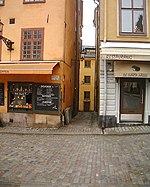Tyska Brinken
Stockholm road stubsStreets in Stockholm

Tyska Brinken (Swedish: The German Slope) is a street in Gamla stan, the old town in central Stockholm, Sweden. Extending Kindstugatan past the German Church down to the square Mälartorget, it is crossed by Skomakargatan, Prästgatan, Västerlånggatan, Stora Nygatan, Lilla Nygatan, and Munkbrogatan, while forming a parallel street to Schönfeldts Gränd and Lejonstedts Gränd.
Excerpt from the Wikipedia article Tyska Brinken (License: CC BY-SA 3.0, Authors, Images).Tyska Brinken
Tyska Brinken, Stockholm Gamla stan (Södermalms stadsdelsområde)
Geographical coordinates (GPS) Address External links Nearby Places Show on map
Geographical coordinates (GPS)
| Latitude | Longitude |
|---|---|
| N 59.323611111111 ° | E 18.070277777778 ° |
Address
Tyska Brinken
Tyska Brinken
111 29 Stockholm, Gamla stan (Södermalms stadsdelsområde)
Sweden
Open on Google Maps










